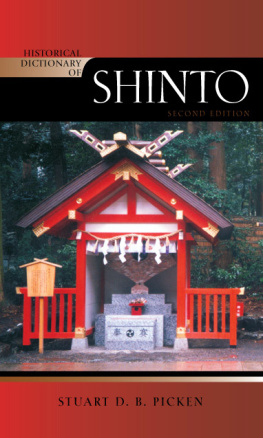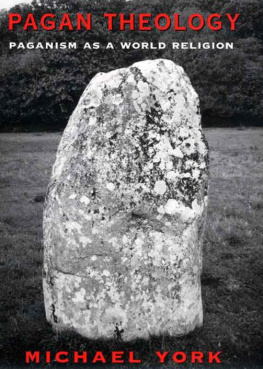Shinto
Shinto
The Way Home
THOMAS P. KASULIS
Dimensions of Asian Spirituality

UNIVERSITY OF HAWAII PRESS
Honolulu
DIMENSIONS OF ASIAN SPIRITUALITY
Henry Rosemont, Jr., General Editor
This series makes available short but comprehensive works on specific Asian philosophical and religious schools of thought, works focused on a specific region, and works devoted to the full articulation of a concept central to one or more of Asias spiritual traditions. Series volumes are written by distinguished scholars in the field who not only present their subject in historical context for the nonspecialist reader but also express their own views of the contemporary spiritual relevance of the subject for global citizens of the twenty-first century.
2004 University of Hawaii Press
All rights reserved
Printed in the United States of America
09 08 07 6 5 4 3
Library of Congress Cataloging-in-Publication Data
Kasulis, Thomas P.
Shinto : the way home / Thomas P. Kasulis.
p. cm.(Dimensions of Asian spirituality)
Includes bibliographical references and index.
ISBN 0-8248-2794-5 (hardcover: alk. paper)
ISBN 0-8248-2850-X (pbk. : alk. paper)
ISBN 978-0-8248-6430-9 (e-book)
1. Shinto. I. Title. II. Series.
BL2220.K38 2004
299.5'61dc22
2004001297
University of Hawaii Press books are printed on acid-free paper and meet the guidelines for permanence and durability of the Council on Library Resources.
Designed by Rich Hendel
Printed by The Maple-Vail Book Manufacturing Group
FOR ELLEN
Contents
Editors Preface
ABOUT THIS SERIES
The University of Hawaii Press has long been noted for its scholarly publications in and commitment to the field of Asian studies. This series, Dimensions of Asian Spirituality, is in keeping with that commitment. It is a most appropriate time for such a series to appear. A number of the worlds religionsmajor and minororiginated in Asia, continue to influence the lives of a third of the worlds peoples, and should now be seen as global in scope, reach, and impact, with rich and varied resources for every citizen of the twenty-first century to explore.
Religion is at the heart of every culture. To be sure, the members of every culture have also been influenced by climate, geology, and the consequent patterns of economic activity they have developed for the production and distribution of goods. Only a rudimentary knowledge of physical geography is necessary to understand why African sculptors largely employed wood as their medium whereas their Italian Renaissance counterparts worked with marble. But while necessary for understanding culturesnot least our ownmatters of geography and economics will not be sufficient: marble is found in China, too, yet the Chinese sculptor carved a bodhisattva, not a piet, from his block.
In the same way, a mosque, synagogue, cathedral, stupa, and pagoda may be equally beautiful, but they are beautiful in different ways, and the differences cannot be accounted for merely on the basis of the materials used in their construction. Their beauty, their power to inspire awe and invite contemplation, rest largely on the religious view of the worldand the place of human beings in that worldexpressed in their architecture. The spiritual dimensions of a culture are reflected significantly not only in art and architecture but in music, myths, poetry, rituals, customs, and patterns of social behavior as well. Therefore it follows that if we wish to understand why and how members of other cultures live as they do, we must understand the religious beliefs and practices to which they adhere.
In the first instance, such understanding of the other leads to tolerance, which is surely a good thing. Much of the pain and suffering in the world today is attributable to intolerance, a fear and hatred of those who look, think, and act differently. But as technological changes in communication, production, and transportation shrink the world, more and more people must confront the fact of human diversity in multiple formsboth between and within nationsand hence there is a growing need to advance beyond mere tolerance of difference to an appreciation and even celebration of it.
The evils attendant on intolerance notwithstanding, tolerance alone cannot contribute substantively to making the world a betterand sustainableplace for human beings to live. Mere tolerance is easy for us: I can fully respect your right to believe and worship as you wish, associate with whomever, and say what you will, simply by ignoring you. You assuredly have a right to speak, but not to make me listen.
Yet for most of us who live in economically developed societies, or are among the affluent in developing nations, tolerance is not enough. Ignoring the poverty, disease, and gross inequalities that afflict fully a third of the human race will only exacerbate, not alleviate, the conditions responsible for the misery that generates the violence becoming ever more commonplace throughout the world today. That violence will cease only when the more fortunate among the peoples of the world become active, take up the plight of the less fortunate, and resolve to create a more just world, a resolve that requires a full appreciation of everyones co-humanity, significant differences in religious beliefs and practices notwithstanding.
Such appreciation should not, of course, oblige everyone to endorse all of the beliefs and practices within their own faith. A growing number of Catholics, for instance, support changes in church practice: a married clergy, the ordination of women, recognition of rights for gays and lesbians, and full reproductive rights for women. Yet they remain Catholics, believing that the tenets of their faith have the conceptual resources to bring about and justify these changes. In the same way, we can also believeas a number of Muslim women dothat the Quran and other Islamic theological writings contain the conceptual resources to overcome the inferior status of women in some Muslim countries. And indeed we can believe that every spiritual tradition has within it the resources to counter older practices inimical to the full flourishing of all the faithfulincluding the faithful of other traditions as well.
Another reason to advance beyond mere tolerance to appreciation and celebration of the many and varied forms of spiritual expression is virtually a truism: the more we look through the window of another cultures beliefs and practices, the more it becomes a mirror of our own (even for those who follow no religious tradition). We must look carefully and charitably, however, or the reflections become distorted. When studying other religions, most people are inclined to focus on cosmological and ontological questions: What do these people believe about the origin of the world and where it is heading? Do they believe in ghosts? Immortal souls? A creator god?
Answering such metaphysical questions is of course necessary for understanding and appreciating the specific forms and content of the art, music, architecture, rituals, and traditions inspired by the specific religion under study. But the sensitiveand sensiblestudent will bracket the further question of whether the metaphysical pronouncements are literally truewe must attend carefully to the metaphysics (and theologies) of the religions we study, but questions of their literal truth should be set aside in order to concentrate on a different question: How could a thoughtful, thoroughly decent human being subscribe to such beliefs and attendant practices?
Studied in this light, we may come to appreciate how each religious tradition provides a coherent account of a world not fully amenable to human manipulation or, perhaps, even to full human understanding. The metaphysical pronouncements of the worlds religions of course differ measurably from faith to faith, and each has had a significant influence on the physical expressions of the respective faith in synagogues, stupas, mosques, pagodas, and cathedrals. Despite these differences between the buildings, however, the careful and sensitive observer can see the spiritual dimensions of human life that these sacred structures share and express. In the same way we can come to appreciate the common spiritual dimensions of each religions differing metaphysics and theology: While the several traditions give different answers to the question of the meaning
Next page











